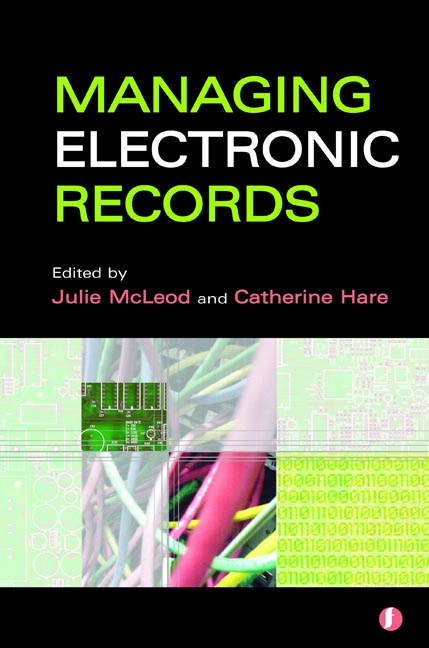Book contents
- Frontmatter
- Contents
- The editors and contributors
- Preface
- 1 The wild frontier ten years on
- 2 The use of standards and models
- 3 Metadata matters
- 4 Digital preservation – ‘the beautiful promise’
- 5 Research in electronic records management
- 6 Technologies for preservation
- 7 Legal issues
- 8 Ethics and electronic recordmaking
- 9 Competencies – the asset that counts most: on developing human talents as a prerequisite for successful EDRM changes
- 10 Records management: two case studies from the French private sector
- 11 Implementing a solution for electronic recordkeeping in the public sector
- 12 Playing the long game – creating and maintaining the links in the value chain
- Index
6 - Technologies for preservation
Published online by Cambridge University Press: 08 June 2018
- Frontmatter
- Contents
- The editors and contributors
- Preface
- 1 The wild frontier ten years on
- 2 The use of standards and models
- 3 Metadata matters
- 4 Digital preservation – ‘the beautiful promise’
- 5 Research in electronic records management
- 6 Technologies for preservation
- 7 Legal issues
- 8 Ethics and electronic recordmaking
- 9 Competencies – the asset that counts most: on developing human talents as a prerequisite for successful EDRM changes
- 10 Records management: two case studies from the French private sector
- 11 Implementing a solution for electronic recordkeeping in the public sector
- 12 Playing the long game – creating and maintaining the links in the value chain
- Index
Summary
Introduction
The InterPARES project (www.interpares.org/) has defined some of the essential requirements for a viable preservation environment. The two concepts of authenticity and integrity are used to express the differences between preservation and simple collection building. Authenticity is the assertion that information about the creation of a record can remain associated with the record throughout the preservation life cycle. Integrity is the assertion that a record can continue to be displayed and manipulated in the manner intended by the original creators. Integrity has associated connotations that the bits that represent the record have not been corrupted, that the management of the record can be audited and the custodians identified, and that the archival processes that have been applied to the record can be tracked.
Preservation can be applied to any digital entity, the string of bits that are generated by a computer program. In the diplomatics field, digital entities correspond to records on which actions are based. The records could be files from office products, images, diplomatic communiqués, or more complex products such as e-mail with attachments. Each of these types of digital entities requires a supporting software and hardware infrastructure for its display and manipulation. The supporting infrastructure may be a file system in which the output from a proprietary office product was stored. The challenge that the archivist faces is that the software and hardware environment that is chosen to provide the long-term preservation is rarely the same as the infrastructure used by the original creator of the record. Archival preservation is the process of extracting a record from its creation environment and migrating the record into the preservation environment (Moore, 2004).
The preservation process must contend with inadequacies in current storage technology. The preservation metadata used to describe authenticity and integrity are normally not maintained by storage systems. Thus information about the creator of a record, the institution that sponsored the creation of a record, or a checksum that can be used to validate the integrity of a record are not stored as attributes in the storage repository along with the record. The preservation environment includes not only storage repositories for the records, but also storage repositories for the preservation metadata.
- Type
- Chapter
- Information
- Managing Electronic Records , pp. 81 - 100Publisher: FacetPrint publication year: 2005



